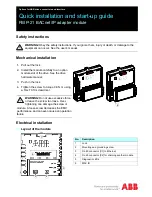
Environmental Temperature Sensor
To ensure that the system is operating within the published limits, the ambient operating
temperature is measured using a sensor placed near the chassis inlet, between the cell boards.
Data from the sensor is used to control the fan speed and to initiate system overtemp shutdown.
Non-Operating Environment
The system is designed to withstand ambient temperatures between -40° to 70° C under
non-operating conditions.
Cooling
Internal Chassis Cooling
The cabinet incorporates front-to-back airflow across the cell boards and system backplane. Two
150 mm fans, mounted externally on the front chassis wall behind the cosmetic front bezel, push
air into the cell section. Two 150 mm fans housed in cosmetic plastic fan carriers, mounted
externally to the rear chassis wall, pull air through the cell section.
Each fan is controlled by a smart fan control board, embedded in the fan module plastic housing.
The smart fan control board receives fan control input from the system fan controller on the
system backplane and returns fan status information to the system fan controller. The smart fan
control board also controls the power and the pulse width modulated control signal to the fan
and monitors the speed indicator back from the fan. The fan status LED is driven by the smart
fan control board.
Bulk Power Supply Cooling
Cooling for the bulk power supplies (BPS) is provided by two 60 mm fans contained within each
BPS. Air flows into the front of the BPS and is exhausted out of the top of the power supply
through upward facing vents near the rear of the supply. The air is then ducted out of the rear
of the chassis with minimal leakage into the cell airflow plenum.
PCI/Mass Storage Section Cooling
Six 92 mm fans located between the mass storage devices and the PCI card cage provide airflow
through these devices. The PCI fans are powered with housekeeping power and run at full speed
at all times. The air is pulled through the mass storage devices and pushed through the PCI Card
Cage. Perforation is provided between the PCI bulkheads to allow adequate exhaust ventilation.
Standby Cooling
Several components within the chassis consume significant amounts of power while the system
is in standby mode. The system fans run at a portion of full speed during standby to remove the
resulting heat from the cabinet. The fans within the power supply will operate at full speed
during standby.
Typical Power Dissipation and Cooling
Table 2-9
provides calculations for configurations for the HP 9000 rp7440 Server. For calculations
for the HP Integrity rx7640 Server, see
Chapter 7
.
Environmental Specifications
39
Summary of Contents for Integrity rx7640
Page 8: ...8 ...
Page 12: ...12 ...
Page 13: ...List of Examples 4 1 Single User HP UX Boot 101 7 1 Single User HP UX Boot 181 13 ...
Page 14: ...14 ...
Page 42: ...42 ...
Page 88: ...88 ...
Page 130: ...Figure 5 8 Core I O Button Locations OLR MP Reset 130 Server Troubleshooting ...
Page 140: ...140 ...
Page 176: ...176 ...
Page 184: ...184 ...
Page 191: ...Figure C 3 Planning Grid Computer Room Layout Plan 191 ...
















































